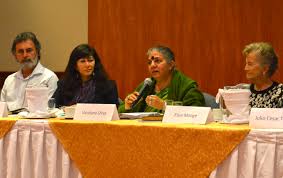A Living Planet, But for How Long?
Oct 3rd, 2014 | By admin | Category: Biodiversity/ConservationBy Suzanne York, www.howmany.org
The Living Planet Report 2014, an analysis of undertaken by World Wildlife Fund, the London Zoological Society, and a few other groups, just reported sobering and disturbing news: the world is losing more species than originally thought, with the state of global wildlife populations halved in 40 years.
The opening paragraph in the report’s forward, written by WWF International director general Marco Lambertini, paints a grim picture:This latest edition of the Living Planet Report is not for the fainthearted. One key point that jumps out and captures the overall picture is that the Living Planet Index (LPI), which measures more than 10,000 representative populations of mammals, birds, reptiles, amphibians and fish, has declined by 52 per cent since 1970. Put another way, in less than two human generations, population sizes of vertebrate species have dropped by half. These are the living forms that constitute the fabric of the ecosystems which sustain life on Earth – and the barometer of what we are doing to our own planet, our only home. We ignore their decline at our peril.
This isn’t “new” news. As humans drill to the ends of the earth for tar sands oil and minerals, destroy virgin rainforests for industrial agriculture, and clear forests for the needs of yet more people, it should come as no surprise that species are being wiped out unprecedented rates.
Lambertini goes on to say that “We really are all connected – and collectively we have the potential to find and adopt the solutions that will safeguard the future of this, our one and only planet.”
We (our global society) already have many of the solutions to halt species loss. It’s just finding the will – mainly political will – to put it all in place. Conservation is one well-known solution, and reducing unsustainable rate of consumption is another. Yet conservation is running out of time, and consumption is a huge issue to tackle. But there are some other, less-well known solutions that can make a big difference now.
It’s All Connected
Key to conserving species is the understanding that conservation can’t exist as a stand-alone solution. One promising initiative is Population, Health and Environment (PHE). This is an integrated approach linking family planning, health and conservation that recognizes the interconnectedness of people, their health and their local environment. It focuses on the direct links between the reproductive health of individuals (both men and women); the health of communities living in remote biodiversity-rich areas; and the health of the natural environment, or ecosystem, upon which all life depends.
Some of the most successful PHE programs are found in Madagascar, a country with great biodiversity, and many species under threat due to human population pressures. In southwest Madagascar, Blue Ventures works with local communities to conserve threatened marine ecosystems and coastal livelihoods. The organization has long understood that there is a connection between population growth, poor natural resource management, environmental degradation, lack of healthcare, and food insecurity. There are other groups having similar success in Ethiopia, the Philippines, and Nepal.
Rights of Nature
Perhaps changing humankind’s relationship with and view of Nature is the most important shift we can undertake today. Seeing Nature not as property but as having rights can be a game-changer. It may not be a “mainstream” concept, but as people plunder the environment for every last resource, we will need to rethink how we interact with the ecosystem.
One official definition of the rights of nature, by the Global Alliance for Rights of Nature, is this:
It is the recognition that our ecosystems – including trees, oceans, animals, mountains – have rights just as human beings have rights. Rights of Nature is about balancing what is good for human beings against what is good for other species, what is good for the planet as a world. It is the holistic recognition that all life, all ecosystems on our planet are deeply intertwined.
People and communities are taking action to promote rights for nature. Earlier this year, a Rights of Nature Ethics Tribunal was convened in Ecuador (which was the first country to include rights of nature in its constitution). Another one is slated for early December, in Peru, during the UN climate negotiations. And in the San Francisco Bay Area, the local Bay Area Rights of Nature Alliance will hold a people’s tribunal on October 5th that considers local violations of community and environmental rights in the context of oil and gas extraction (with a focus on the Chevron refinery in Richmond, CA) and will put forth a new vision for living in harmony with all life.
What Will the Future Hold?
Looking ahead, we can expect to see more loss of biodiversity unless we stop with business as usual and change course.
Who wants to live on a scarred planet devoid of amazing and beautiful flora and fauna simply because people couldn’t be bothered to change ways detrimental to the rest of the earth?



